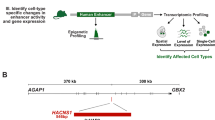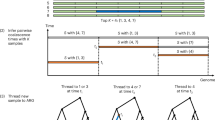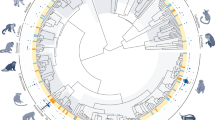Abstract
Sequencing DNA derived from archaic bones has enabled genetic comparison of Neanderthals and anatomically modern humans (AMHs), and revealed that they interbred. However, interpreting what genetic differences imply about their phenotypic differences remains challenging. Here, we introduce an approach for identifying divergent gene regulation between archaic hominins, such as Neanderthals, and AMH sequences, and find 766 genes that are likely to have been divergently regulated (DR) by Neanderthal haplotypes that do not remain in AMHs. DR genes include many involved in phenotypes known to differ between Neanderthals and AMHs, such as the structure of the rib cage and supraorbital ridge development. They are also enriched for genes associated with spontaneous abortion, polycystic ovary syndrome, myocardial infarction and melanoma. Phenotypes associated with modern human variation in these genes’ regulation in ~23,000 biobank patients further support their involvement in immune and cardiovascular phenotypes. Comparing DR genes between two Neanderthals and a Denisovan revealed divergence in the immune system and in genes associated with skeletal and dental morphology that are consistent with the archaeological record. These results establish differences in gene regulatory architecture between AMHs and archaic hominins, and provide an avenue for exploring phenotypic differences between archaic groups from genomic information alone.
This is a preview of subscription content, access via your institution
Access options
Access Nature and 54 other Nature Portfolio journals
Get Nature+, our best-value online-access subscription
$29.99 / 30 days
cancel any time
Subscribe to this journal
Receive 12 digital issues and online access to articles
$119.00 per year
only $9.92 per issue
Buy this article
- Purchase on Springer Link
- Instant access to full article PDF
Prices may be subject to local taxes which are calculated during checkout





Similar content being viewed by others
Data availability
All data reported in this paper are available from the project’s GitHub repository (https://github.com/colbrall/neanderthal_predixcan_manuscript).
Code availability
All code used in this paper is available from the project’s GitHub repository (https://github.com/colbrall/neanderthal_predixcan_manuscript).
References
Green, R. E. et al. A draft sequence of the Neandertal genome. Science 328, 710–722 (2010).
Reich, D. et al. Genetic history of an archaic hominin group from Denisova Cave in Siberia. Nature 468, 1053–1060 (2010).
Prüfer, K. et al. A high-coverage Neandertal genome from Vindija Cave in Croatia. Science 358, 655–658 (2017).
Hajdinjak, M. et al. Reconstructing the genetic history of late Neanderthals. Nature 555, 652–656 (2018).
Wolf, A. B. & Akey, J. M. Outstanding questions in the study of archaic hominin admixture. PLoS Genet. 14, e1007349 (2018).
Sawyer, S. et al. Nuclear and mitochondrial DNA sequences from two Denisovan individuals. Proc. Natl Acad. Sci. USA 112, 15696–15700 (2015).
Prüfer, K. et al. The complete genome sequence of a Neanderthal from the Altai Mountains. Nature 505, 43–49 (2014).
Vernot, B. et al. Excavating Neandertal and Denisovan DNA from the genomes of Melanesian individuals. Science 352, 235–239 (2016).
Sankararaman, S., Mallick, S., Patterson, N. & Reich, D. The combined landscape of Denisovan and Neanderthal ancestry in present-day humans. Curr. Biol. 26, 1241–1247 (2016).
Simonti, C. N. et al. The phenotypic legacy of admixture between modern humans and Neandertals. Science 351, 737–741 (2016).
Castellano, S. et al. Patterns of coding variation in the complete exomes of three Neandertals. Proc. Natl Acad. Sci. USA 111, 6666–6671 (2014).
Dannemann, M., Prüfer, K. & Kelso, J. Functional implications of Neandertal introgression in modern humans. Genome Biol. 18, 61 (2017).
McCoy, R. C., Wakefield, J. & Akey, J. M. Impacts of Neanderthal-introgressed sequences on the landscape of human gene expression. Cell 168, 916–927.e12 (2017).
Gamazon, E. R. et al. A gene-based association method for mapping traits using reference transcriptome data. Nat. Genet. 47, 1091–1098 (2015).
GTEx Consortium Genetic effects on gene expression across human tissues. Nature 550, 204–213 (2017).
Martin, A. R. et al. Human demographic history impacts genetic risk prediction across diverse populations. Am. J. Hum. Genet. 100, 635–649 (2017).
Martin, A. R. et al. Clinical use of current polygenic risk scores may exacerbate health disparities. Nat. Genet. 51, 584–591 (2019).
Kim, M. S., Patel, K. P., Teng, A. K., Berens, A. J. & Lachance, J. Genetic disease risks can be misestimated across global populations. Genome Biol. 19, 179 (2018).
Mostafavi, H., Harpak, A., Conley, D., Pritchard, J. K. & Przeworski, M. Variable prediction accuracy of polygenic scores within an ancestry group. Preprint at bioRxiv https://www.biorxiv.org/content/10.1101/629949v1 (2019).
The 1000 Genomes Project Consortium A global reference for human genetic variation. Nature 526, 68–74 (2015).
Abi-Rached, L. et al. The shaping of modern human immune systems by multiregional admixture with archaic humans. Science 334, 89–94 (2011).
Dannemann, M. & Kelso, J. The contribution of Neanderthals to phenotypic variation in modern humans. Am. J. Hum. Genet. 101, 578–589 (2017).
Wada, H., Tanaka, H., Nakayama, S., Iwasaki, M. & Okamoto, H. Frizzled3a and Celsr2 function in the neuroepithelium to regulate migration of facial motor neurons in the developing zebrafish hindbrain. Development 133, 4749–4759 (2006).
Skibinski, G. et al. Mutations in the endosomal ESCRTIII-complex subunit CHMP2B in frontotemporal dementia. Nat. Genet. 37, 806–808 (2005).
Cox, L. E. et al. Mutations in CHMP2B in lower motor neuron predominant amyotrophic lateral sclerosis (ALS). PLoS ONE 5, e9872 (2010).
McDowell, K. A. et al. Reduced cortical BDNF expression and aberrant memory in Carf knock-out mice. J. Neurosci. 30, 7453–7465 (2010).
Schumer, M. et al. Natural selection interacts with the local recombination rate to shape the evolution of hybrid genomes. Science 3684, 656–660 (2018).
Gokhman, D. et al. Reconstructing the DNA methylation maps of the Neandertal and the Denisovan. Science 344, 523–527 (2014).
Meyer, M. et al. A high-coverage genome sequence from an archaic Denisovan individual. Science 338, 222–226 (2012).
Brawand, D. et al. The evolution of gene expression levels in mammalian organs. Nature 478, 343–348 (2011).
Gokhman, D. et al. Extensive regulatory changes in genes affecting vocal and facial anatomy separate modern from archaic humans. Preprint at bioRxiv https://www.biorxiv.org/content/10.1101/106955v13 (2017).
Martin, A. R. et al. Transcriptome sequencing from diverse human populations reveals differentiated regulatory architecture. PLoS Genet. 10, 1004549 (2014).
Kelly, D. E., Hansen, M. E. B. & Tishkoff, S. A. Global variation in gene expression and the value of diverse sampling. Curr. Opin. Syst. Biol. 1, 102–108 (2017).
Hernandez, R. D. et al. Ultrarare variants drive substantial cis heritability of human gene expression. Nat. Genet. 51, 1349–1355 (2019).
Glassberg, E. C., Gao, Z., Harpak, A., Lan, X. & Pritchard, J. K. Evidence for weak selective constraint on human gene expression. Genetics 211, 757–772 (2019).
Liu, X., Li, Y. I. & Pritchard, J. K. Trans effects on gene expression can drive omnigenic inheritance. Cell 177, 1022–1034.e6 (2019).
Gel, B. & Serra, E. karyoploteR: an R/Bioconductor package to plot customizable genomes displaying arbitrary data. Bioinformatics 33, 3088–3090 (2017).
The 1000 Genomes Project Consortium An integrated map of genetic variation from 1,092 human genomes. Nature 491, 56–65 (2012).
Hinch, A. G. et al. The landscape of recombination in African Americans. Nature 476, 170–175 (2011).
Doan, R. N. et al. Mutations in human accelerated regions disrupt cognition and social behavior. Cell 167, 341–354.e12 (2016).
Wang, J., Vasaikar, S., Shi, Z., Greer, M. & Zhang, B. WebGestalt 2017: a more comprehensive, powerful, flexible and interactive gene set enrichment analysis toolkit. Nucleic Acids Res. 45, W130–W137 (2017).
Acknowledgements
We thank C. Simonti, D. Rinker, M. L. Benton, N. Creanza, E. Hodges and S. Francis for helpful discussions and comments on the manuscript. L.L.C. was funded by NIH grant T32GM080178 to Vanderbilt University. J.A.C. was funded by NIH grants R01GM115836 and R35GM127087, the March of Dimes Prematurity Research Center Ohio Collaborative and the Burroughs Wellcome Fund. E.R.G. acknowledges support from R01MH101820, R01MH090937 and R01MH113362. E.R.G. is grateful to the President and Fellows of Clare Hall, University of Cambridge for fellowship support and is supported by the National Human Genome Research Institute of the National Institutes of Health under Award Number R35HG010718. This work was conducted in part using the resources of the Advanced Computing Center for Research and Education at Vanderbilt University, and was based in part on data from the PredixVU system of Vanderbilt University Medical Center. This research is solely the responsibility of the authors and does not necessarily represent the views of Vanderbilt University Medical Center.
Author information
Authors and Affiliations
Contributions
L.L.C. and J.A.C. designed and conducted the experiments. E.R.G. was responsible for the technical design and implementation of the PrediXcan system, and performed the cross-population validation analysis. E.R.G. and D.Z. retrained the models and performed the analysis of predictive power by introgression status. E.R.G., P.E. and N.J.C. designed the PredixVU system and advised on its use. L.L.C. and J.A.C. wrote the manuscript. All authors revised and approved the manuscript for publication.
Corresponding author
Ethics declarations
Competing interests
The authors declare no competing interests.
Additional information
Publisher’s note Springer Nature remains neutral with regard to jurisdictional claims in published maps and institutional affiliations.
Supplementary information
Supplementary Information
Supplementary text, Figs. 1–13 and Tables 1–4.
Rights and permissions
About this article
Cite this article
Colbran, L.L., Gamazon, E.R., Zhou, D. et al. Inferred divergent gene regulation in archaic hominins reveals potential phenotypic differences. Nat Ecol Evol 3, 1598–1606 (2019). https://doi.org/10.1038/s41559-019-0996-x
Received:
Accepted:
Published:
Issue Date:
DOI: https://doi.org/10.1038/s41559-019-0996-x
This article is cited by
-
More than a decade of genetic research on the Denisovans
Nature Reviews Genetics (2024)
-
Archaic hominin traits through the splicing lens
Nature Ecology & Evolution (2023)
-
Resurrecting the alternative splicing landscape of archaic hominins using machine learning
Nature Ecology & Evolution (2023)
-
Brain region-specific effects of nearly fixed sapiens-derived alleles
BMC Genomic Data (2022)
-
Integrative transcriptomic, evolutionary, and causal inference framework for region-level analysis: Application to COVID-19
npj Genomic Medicine (2022)



